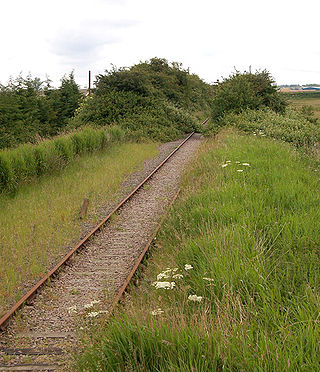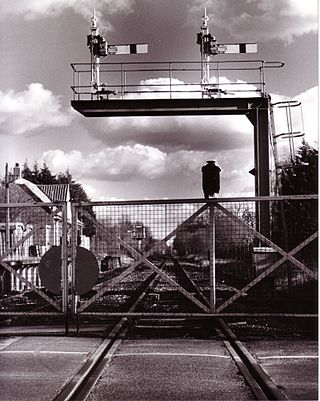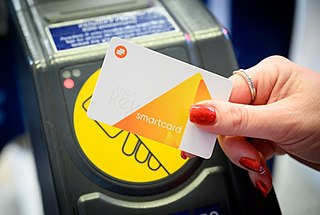British Railways (BR), which from 1965 traded as British Rail, was a state-owned company that operated most of the overground rail transport in Great Britain from 1948 to 1997. It was formed from the nationalisation of the Big Four British railway companies, and was privatised in stages between 1994 and 1997. Originally a trading brand of the Railway Executive of the British Transport Commission, it became an independent statutory corporation in January 1963, when it was formally renamed the British Railways Board.
National Rail (NR) is the trading name licensed for use by the Rail Delivery Group, an unincorporated association whose membership consists of the passenger train operating companies (TOCs) of England, Scotland, and Wales. The TOCs run the passenger services previously provided by the British Railways Board, from 1965 using the brand name British Rail. Northern Ireland, which is bordered by the Republic of Ireland, has a different system. National Rail services share a ticketing structure and inter-availability that generally do not extend to services which were not part of British Rail.

Thameslink is a 24-hour main-line route in the British railway system, running from Bedford, Luton, St Albans City, Peterborough, Welwyn Garden City, London Blackfriars and Cambridge via central London to Sutton, Orpington, Sevenoaks, Rainham, Horsham, Three Bridges, Brighton and East Grinstead. The network opened as a through service in 1988, with severe overcrowding by 1998, carrying more than 28,000 passengers in the morning peak. All the services are currently operated by Govia Thameslink Railway.
The Rail Delivery Group Limited (RDG), previously the Association of Train Operating Companies, is the British rail industry membership body that brings together passenger and freight rail companies, Network Rail and High Speed 2.

King's Cross St Pancras is a London Underground station on Euston Road in the Borough of Camden, Central London. It serves King's Cross and St Pancras main line stations in fare zone 1, and is an interchange between six Underground lines. The station was one of the first to open on the network. As of 2021, it is the most used station on the network for passenger entrances and exits combined.

St Pancras railway station, also known as London St Pancras or St Pancras International and officially since 2007 as London St Pancras International, is a central London railway terminus on Euston Road in the London Borough of Camden. It is the terminus for Eurostar services from Belgium, France and the Netherlands to London. It provides East Midlands Railway services to Leicester, Corby, Derby, Sheffield and Nottingham on the Midland Main Line, Southeastern high-speed trains to Kent via Ebbsfleet International and Ashford International, and Thameslink cross-London services to Bedford, Cambridge, Peterborough, Brighton, Horsham and Gatwick Airport. It stands between the British Library, the Regent's Canal and London King's Cross railway station, with which it shares a London Underground station, King's Cross St Pancras.

King's Cross Thameslink station is a closed railway station in central London, England. It is located on Pentonville Road, around 250 metres (0.2 mi) east of King's Cross mainline station. At the time of closure, in 2007, it was served by Thameslink trains and managed by First Capital Connect. Services have been transferred to a new station underneath St Pancras.

Network SouthEast (NSE) was one of the three passenger sectors of British Rail created in 1982. NSE mainly operated commuter rail trains within Greater London and inter-urban services in densely populated South East England, although the network went as far west as Exeter. Before 1986, the sector was originally known as London & South Eastern.

The Wisbech and March line is a railway line between March and Wisbech in Cambridgeshire, England. A number of proposals are currently being investigated relating to the possible restoration of passenger services along the route.

Luton Airport Parkway railway station is on the Midland Main Line in England, serving south Luton and Luton Airport in Bedfordshire. The station is situated in Luton's Park Town district, being 29.27 miles (47.11 km) from London St Pancras between Harpenden to the south and Luton to the north. Its three-letter station code is LTN, also the IATA code for the airport.

The London station group is a group of 18 railway stations served by the National Rail network in central London. The group contains all 14 terminal stations in central London, either serving major national services or local commuter routes, and 4 other through-stations that are considered terminals for ticketing purposes. All current stations in the group fall within London fare zone 1. A ticket marked "London Terminals" allows travel to any station in the group via any permitted route, as determined by the National Routeing Guide.
There is no single 'discount railcard' available on the UK railway network. In addition to the large number and variety of short-term or localised promotional fares that have been available to passengers on the British railway network in recent decades, there are many permanent concessionary fare schemes available to passengers. Some of these take the form of Railcards, which can be purchased by people who qualify according to the conditions, and which give discounts for all journeys over a period; other concessions are available for individual journeys. In all cases, details of the type of concession will be printed on the passenger's travel ticket, to distinguish reduced-rate tickets from those sold at the standard full fare.

The period from 1995 covers the history of rail transport in Great Britain following the privatisation of British Rail. During this period, passenger volumes have grown rapidly, safety has improved, and subsidies per journey have fallen. However, there is debate as to whether this is due to privatisation or to better government regulation. During this period, High Speed 1, the West Coast Main Line upgrade and Crossrail were completed and more construction projects are currently under way. The period also saw the demise of privately-owned Railtrack and its replacement with government-owned Network Rail.

The 16–25 Railcard is an annual card giving discounts on certain types of railway ticket in Britain. It is available to anybody aged between 16 and 25 (inclusive), and certain mature students aged 26 and above, and is currently priced at £30.00. There is no restriction on the number of times the Railcard can be used to purchase discounted tickets during the period of its validity, and there are no geographical restrictions on its use.

Blyth railway station served Blyth, Northumberland on the Blyth Branch line in Northeast England.
The Disabled Persons Railcard is a concessionary fare scheme in the United Kingdom giving eligible passengers with disabilities benefits on the National Rail network including a 1/3 discount on fares.

The British Rail Class 700 is an electric multiple unit passenger train from the Desiro City family built by Siemens Mobility. It is capable of operating on 25 kV 50 Hz AC from overhead wires or 750 V DC from third rail. 115 trainsets were built between 2014 and 2018, for use on the Thameslink network, as part of the Thameslink Programme in the United Kingdom. As of 2021, they are operated by Govia Thameslink Railway.

Marchwood railway station was an intermediate station on the Totton, Hythe and Fawley Light Railway, which was built along the coast of Southampton Water to connect Totton and Fawley and to provide a freight link from the South West Main Line to Fawley Refinery. It was 86 miles 10 chains measured from London Waterloo.

The Key is a contactless ITSO-compatible smartcard developed by the Go-Ahead Group used on buses, trains and other forms of public transport across various areas of the United Kingdom.

The Castlefield corridor is a railway corridor between Castlefield junction and Fairfield Street junction in Greater Manchester, England. The corridor forms the eastern end of the southerly Liverpool–Manchester line.














